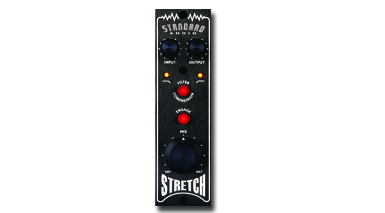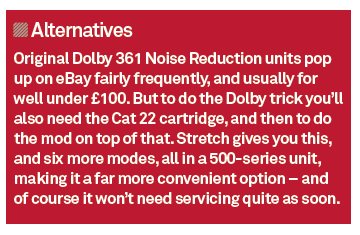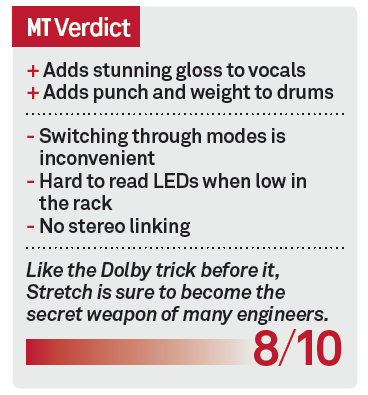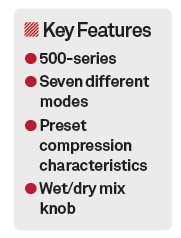Standard Audio Stretch Review
Stretch is based on an old studio secret. Mike Hillier reveals all… Details Price £579 Contact KMR Audio 0208 445 2446 Web www.standard-audio.com Amazon.co.uk Widgets Well here’s an interesting module. The Standard Audio Stretch is a multi-band compressor inspired by a selection of noise-reduction units from the 70s and 80s. It’s pretty much the case […]

Stretch is based on an old studio secret. Mike Hillier reveals all…

Details
Price £579
Contact KMR Audio 0208 445 2446
Web www.standard-audio.com
Well here’s an interesting module. The Standard Audio Stretch is a multi-band compressor inspired by a selection of noise-reduction units from the 70s and 80s. It’s pretty much the case that there’s really no need for noise reduction with modern equipment, and even if there were, software such as iZotope RX can clean audio far better than noise reduction hardware. This may all be true, but that’s not what Stretch has been developed for…
The Art of Noise
Soon after noise-reduction units came into use, enterprising engineers started using them during mixing and they quickly became secret weapons of mixers ‘in the know’. Some engineers even went as far as to modify their units, with one of the most popular mods being known as the ‘Stretch’ mod – from which the Standard Audio Stretch takes its name.
Stretch splits the signal into four bands: 20-110Hz, 110Hz-3kHz, 3-20kHz and 9-20kHz. It then compresses each of these with preset threshold, ratio, attack and release settings tailored to each. The user is limited to only a few controls: input and output levels, a wet/dry blend, a bypass switch and a mode switch. In essence, then, Stretch is incredibly easy to use: select the mode you want, dial up the input until you’re getting the amount of compression you need, and dial the output to keep optimum gain structure into the next device.
The seven modes on Stretch enable or disable each of the various bands. Of the four bands the two high-bands overlap, and this is because the top-most band behaves more like a simple EQ, adding a little top-end sparkle to the mix.
The original Dolby ‘stretch’ mod involved bypassing the low- and mid-frequency parts and only using the high band, so we began our experiments by engaging that mode and running a lead vocal part from a modern RnB mix through the Stretch. With only the 3-20kHz band engaged and the mix knob set to 100%, Stretch doesn’t just leave the bottom end untouched, it filters it out completely, meaning this is only really of use in a parallel buss set-up.
Dialling it down to around 40% produced a vocal performance that was more open and glossy than the original. Engaging the 9-20kHz band adds further air to the vocal, helping it to sit in front of the mix without seeming to take over. For this type of vocal, Stretch seems like almost the perfect tool.
Next we put the Stretch across the kick drum, and switched through the modes. The low-frequency-only mode gave a consistency to the low end and added a little weight, even tidying the sound up a little, but switching over to the low- and high-end mode helped to push the kick forward in the mix, adding more punch and definition to the kick, creating a mid-scooped EQ tone without any additional EQ.
A pair of Stretch units would make an excellent addition to overheads, drum buss, or even the stereo buss. However, with only a single unit we were still eager to give it a go, and placed Stretch across a mono version of our overheads, dialled in a tone we liked using all four bands at once, and then bounced the left and right channels through the single unit one after the other. The end result was a more exciting, open drum sound with a little more width than the dry signal.
Dynamic Stretching
Stretch is incredibly easy to use, and dialling in exciting tones takes no time at all. Our only reservation is that as you switch through the different modes, it is often the case that you quickly narrow it down to one of two; and, unfortunately, to go between them involves switching through all the other modes, which can be a little annoying.

Similarly, the two LEDs can be a little difficult to see if the unit is low in the rack, as the input and output knobs get in the way of your line of sight. However, these are minor niggles, and in no way detract from the fantastic sounds we were able to get.
Stretch is far from a studio essential, but once you’ve added it to your rack you’ll more than likely find yourself running more and more through it. As a vocal processor, Stretch adds a sparkle to the top end that is very easy to get to, and couldn’t be achieved with simple compression or EQ alone.




